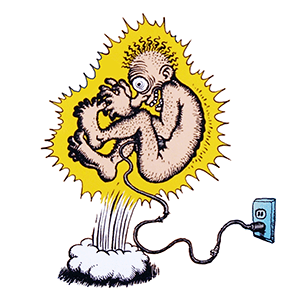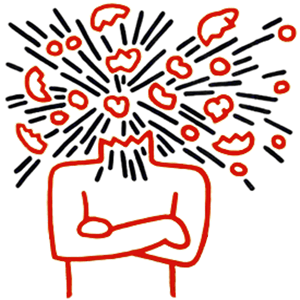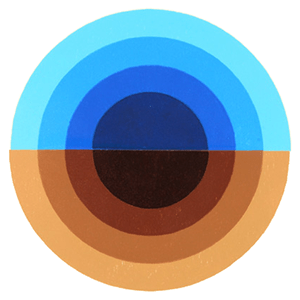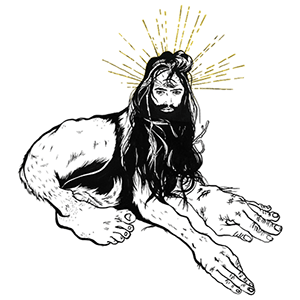Hypnagogia [hip-nuh-gah-jee-uh] is a term coined by French physician Alfred Maury in the 19th century for the transitional state between wakefulness and sleep (i.e. the onset of sleep). It is characterized by dreamlike auditory, visual, or tactile sensations.
Sometimes the word hypnagogia is used in a restricted sense to refer to the onset of sleep, and contrasted with hypnopompia, Frederic Myers’s term for waking up. The hypnagogic state can provide insight into a problem, the best known example being August Kekulé’s realization that the structure of benzene was a closed ring after dozing in front of a fire and seeing atoms forming into snakes, one of who grabbed its tail in its mouth.
read more »
Hypnagogia
Nootropic
Nootropics [no-eh-tro-pik], also referred to as smart drugs or memory enhancers, are drugs that improve mental functions such as cognition, memory, intelligence, motivation, attention, and concentration. The word nootropic was coined in 1972 by Dr. Corneliu E. Giurgea of Romania, derived from the Greek words nous, or ‘mind,’ and trepein meaning ‘to bend/turn.’
Nootropics are thought to work by altering the availability of the brain’s supply of neurochemicals (neurotransmitters, enzymes, and hormones), by improving the brain’s oxygen supply, or by stimulating nerve growth. However the efficacy of nootropic substances, in most cases, has not been conclusively determined. This is complicated by the difficulty of defining and quantifying cognition and intelligence.
read more »
Microsleep
A microsleep is an episode of sleep which may last for a fraction of a second or up to thirty seconds. Often, it is the result of sleep deprivation, mental fatigue, depression, sleep apnea, hypoxia, narcolepsy, or hypersomnia. For the sleep-deprived, microsleeping can occur at any time, typically without substantial warning. Microsleeps become extremely dangerous when they occur in situations which demand constant alertness, such as driving a motor vehicle or working with heavy machinery. People who experience microsleeps usually remain unaware of them, instead believing themselves to have been awake the whole time, or to have temporarily lost focus.
There is little agreement on how best to identify microsleep episodes. Some experts define microsleep according to behavioral criteria (head nods, drooping eyelids, etc.), while others rely on EEG markers. When experiencing microsleeps while driving an automobile, from the perspective of the driver, he or she drives a car, and then suddenly realizes that several seconds have passed by unnoticed. It is not obvious to the driver that he or she was asleep during those missing seconds, although this is in fact what happened. The sleeping driver is at very high risk for having an accident during a microsleep episode.
Power Nap
A power nap is a short sleep which terminates before the occurrence of deep sleep or slow-wave sleep (SWS), intended to quickly revitalize the subject. The expression was coined by Cornell University social psychologist James Maas. The power nap is thought to maximize the benefits of sleep versus time. It is used to supplement normal sleep, especially when a sleeper has accumulated a sleep deficit. Scientific experiments and anecdotal evidence suggest that an average power nap duration of around 15–30 minutes is most effective. Any more time, and the body enters into its usual sleep cycle.
Various durations are recommended for power naps, which are very short compared to regular sleep. The short duration of a power nap is designed to prevent nappers from sleeping so long that they enter a normal sleep cycle without being able to complete it. Entering a normal sleep cycle, but failing to complete it, can result in a phenomenon known as sleep inertia, where one feels groggy, disoriented, and even more sleepy than before beginning the nap. In order to attain maximum post-nap performance, it is critical that a power nap be limited to the beginning of a sleep cycle, specifically sleep stages I and II.
read more »
Brain Zap
Symptoms described as ‘brain zaps,’ ‘brain shocks,’ ‘brain shivers,’ or ‘cranial zings’ are a withdrawal symptom experienced during discontinuation (or reduction of dose) of antidepressant drugs. The symptoms are widely variable in description and of unknown etiology; common descriptions include dizziness, electric shock-like sensations, sweating, nausea, insomnia, tremor, confusion, nightmares, and vertigo.
The ‘preferred term’ for coding these types of symptoms in adverse drug reaction reports is ‘paraesthesia’ (more generally known as the feeling of ‘pins and needles’).
Exploding Head Syndrome
Exploding head syndrome is a parasomnia condition (sleep disorder) that causes the sufferer occasionally to experience a tremendously loud noise as originating from within his or her own head, usually described as the sound of an explosion, roar, gunshot, loud voices or screams, a ringing noise, or the sound of electrical arcing (buzzing). This noise usually occurs within an hour or two of falling asleep, but is not necessarily the result of a dream and can happen while awake as well. While the sound is perceived as extremely loud, it is usually not accompanied by pain. In some cases an instant flash of what is perceived as video ‘static’ is reported.
Attacks appear to change in number over time, with several attacks occurring in a space of days or weeks followed by months of remission. Sufferers often feel a sense of fear and anxiety after an attack, accompanied by elevated heart rate. Attacks are also often accompanied by perceived flashes of light (when perceived on their own, known as a ‘visual sleep start’) or difficulty in breathing. The condition is also known as ‘auditory sleep starts.’ It is not thought to be dangerous, although it is sometimes distressing to experience. Sufferers may experience an inability to vocalize any sound, or mild forms of sleep paralysis during an attack.
read more »
Life Review
A life review is a phenomenon widely reported as occurring during near-death experiences, in which a person rapidly sees much or the totality of his or her life history in chronological sequence and in extreme detail. It is often referred to by people having experienced this phenomenon as having their life ‘flash before their eyes.’
A reformatory purpose seems commonly implicit in accounts, though not necessarily for earthly purpose, since return from a near-death experience may reportedly entail individual choice. While individuals sometimes report reviews took place in the company of otherworldly beings who shared the observation, they also say they felt unjudged during the process, leaving themselves their own strongest critics.
read more »
Out of Body Experience
An out-of-body experience (OBE) is an experience that typically involves a sensation of floating outside of one’s body and, in some cases, perceiving one’s physical body from a place outside one’s body (autoscopy). The term was introduced in 1943 by G.N.M Tyrrell in his book ‘Apparitions,’ and adopted as a bias-free alternative to belief-centric labels such as ‘astral projection,’ ‘soul travel,’ or ‘spirit walking.’
Though the term usefully distances researchers from scientifically problematic concepts such as the soul, scientists still know little about the phenomenon. Some researchers believe they have managed to recreate OBE in a laboratory setup by stimulating a part in the human brain. One in ten people has an out-of-body experience once, or more commonly, several times in their life. OBEs are often part of the near-death experience. Those who have experienced OBEs sometimes claim to have observed details which were unknown to them beforehand.
read more »
Binaural Beats
Binaural [bahy-nawr-uhl] beats or binaural tones are auditory processing artifacts, or apparent sounds, the perception of which arises in the brain for specific physical stimuli. This effect was discovered in 1839 by Heinrich Wilhelm Dove, and earned greater public awareness in the late 20th century based on claims that binaural beats could help induce relaxation, meditation, creativity and other desirable mental states. The effect on the brainwaves depends on the difference in frequencies of each tone, for example, if 300 Hz was played in one ear and 310 in the other, then the Binaural beat would have a frequency of 10 Hz.
The brain produces a phenomenon resulting in low-frequency pulsations in the amplitude and sound localization of a perceived sound when two tones at slightly different frequencies are presented separately, one to each of a subject’s ears, using stereo headphones. A beating tone will be perceived, as if the two tones mixed naturally, out of the brain. The frequencies of the tones must be below 1,000 hertz for the beating to be noticeable. The difference between the two frequencies must be small (less than or equal to 30 Hz) for the effect to occur; otherwise, the two tones will be heard separately and no beat will be perceived. Binaural beats reportedly influence the brain in more subtle ways through the entrainment of brainwaves and have been claimed to reduce anxiety and provide other health benefits such as control over pain.
read more »
Psychowalkman
A mind machine (or psychowalkman) uses pulsing rhythmic sound and/or flashing light to alter the brainwave frequency of the user. Mind machines are said to induce deep states of relaxation, concentration, and in some cases altered states of consciousness that have been compared to those obtained from meditation and shamanic rituals. The process applied by these machines is also known as brainwave synchronization or entrainment. Mind machines typically consist of a control unit, a pair of headphones and/or strobe light goggles. The unit controls the sessions and drives the LEDs in the goggles. Professionally, they are usually referred to as Auditory Visual Stimulation devices (AVS). Sessions will typically aim at directing the average brainwave frequency from a high level to a lower level by ramping down in several sequences. Target frequencies typically correspond to delta (1-3 hertz), theta (4–7 Hz), alpha (8–12 Hz) or beta brain waves (13–40 Hz), and can be adjusted by the user based on the desired effects.
There have been a number of claims regarding binaural beats (auditory processing artifacts or apparent sounds), among them that they may help people memorize and learn, stop smoking, tackle erectile dysfunction and improve athletic performance. However, research into binaural beats is very limited. No conclusive studies have been released to support marketing claims for binaural beat systems. Mind machines are often used together with biofeedback or neurofeedback equipment in order to adjust the frequency on the fly. Modern mind machines can connect to the Internet to update the software and download new sessions. When sessions are used in conjunction with meditation, neurofeedback, etc. the effect can be amplified. Rapidly flashing lights may be dangerous for people with photosensitive epilepsy or other nervous disorders. It is thought that one out of 10,000 adults will experience a seizure while viewing such a device; about twice as many children will have a similar ill effect.
Zihuatanejo Project
The Zihuatanejo Project was an intentional community created during the summers of 1962 and 1963 by Timothy Leary and Richard Alpert under the umbrella of their nonprofit group, the International Federation for Internal Freedom (IFIF). The community was located in Zihuatanejo, Mexico, and took up residence at the Catalina Hotel. The idea for the community was based on the fictional story from Aldous Huxley’s 1962 novel, ‘Island.’ Immigration officials were tipped off to the project when the Mexican media began reporting stories about an ‘LSD Paradise.’ In the summer of 1963, after only six weeks the Mexican authorities shut the community down.
More than 5,000 people applied to the IFIF in the hopes of joining the project in Zihuatanejo. Out of this pool of applicants, a small, select group of people were chosen. Amenities cost $200 a month per person, including food and lodging in bungalows near a secluded beach. Fishermen supplied a bounty of fresh fish from the bay. Leary and 35 guests rented the Catalina Hotel for a month using the ‘Tibetan Book of the Dead’ as a guide book for LSD sessions, while Ralph Metzner and Richard Alpert helped manage the group. Group LSD sessions began in the morning with the consumption of liquid LSD, with a dosage of 100 to 500 micrograms ingested by participating individuals; the experience would usually last until late afternoon.
Psychedelic Experience
The term ‘psychedelic experience‘ is vague – characterized by polyvalence or ambiguity due to its nature – however in modern psychopharmacological science as well as philosophical, psychological, neurological, spiritual-religious and most other ideological discourses it is understood as an altered state of awareness often distinct to, and induced by the consumption of certain psychotropics.
In particular hallucinogens, many entheogens and specifically psychedelic compounds are known to cause this change in mental state.
read more »













